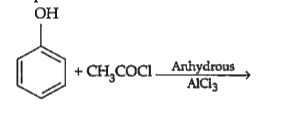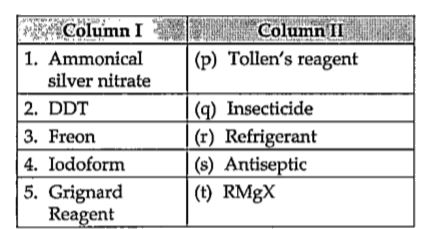FILL IN THE BLANKS from KALYANI CHEMISTRY (ENGLISH) HALOALKANES AND HALOARENES for Class 12
| Class 12 | CHEMISTRY |
| Chapter | HALOALKANES AND HALOARENES |
| KALYANI CHEMISTRY (ENGLISH) | FILL IN THE BLANKS |
| Medium | English |
| Academic Year | 2023-2024 |
Question 58
Read the passage given below and answer the following questions: Haloalkanes and alcohols are important starting materials in the synthesis of compounds having other functional groups. Primary haloalkanes react with hydroxide ion to give alcohols, although we will see that elimination reactions compete with substitution for secondary and tertiary halides. When comparing alkanes and haloalkanes, we will see that haloalkanes have higher boiling points than alkanes containing the same number of carbons. London dispersion forces are the first of two types of forces that contribute to this physical property. London dispersion forces increase with molecular surface area. In comparing haloalkanes with alkanes, haloalkanes exhibit an increase in surface area due to the substitution of a halogen for hydrogen. The increase in surface area leads to an increase in London dispersion forces, which then results in a higher boiling point

Which of the following undergoes nucleophilic substitution exclusively by S1N mechanism?View SolutionQuestion 59
Read the passage given below and answer the following questions: Haloalkanes and alcohols are important starting materials in the synthesis of compounds having other functional groups. Primary haloalkanes react with hydroxide ion to give alcohols, although we will see that elimination reactions compete with substitution for secondary and tertiary halides. When comparing alkanes and haloalkanes, we will see that haloalkanes have higher boiling points than alkanes containing the same number of carbons. London dispersion forces are the first of two types of forces that contribute to this physical property. London dispersion forces increase with molecular surface area. In comparing haloalkanes with alkanes, haloalkanes exhibit an increase in surface area due to the substitution of a halogen for hydrogen. The increase in surface area leads to an increase in London dispersion forces, which then results in a higher boiling point

Which of the following is most reactive towards S1N reaction?View SolutionQuestion 60
Read the passage given below and answer the following questions: Haloalkanes and alcohols are important starting materials in the synthesis of compounds having other functional groups. Primary haloalkanes react with hydroxide ion to give alcohols, although we will see that elimination reactions compete with substitution for secondary and tertiary halides. When comparing alkanes and haloalkanes, we will see that haloalkanes have higher boiling points than alkanes containing the same number of carbons. London dispersion forces are the first of two types of forces that contribute to this physical property. London dispersion forces increase with molecular surface area. In comparing haloalkanes with alkanes, haloalkanes exhibit an increase in surface area due to the substitution of a halogen for hydrogen. The increase in surface area leads to an increase in London dispersion forces, which then results in a higher boiling point

The addition of HBr is easiest in which one of the following substrates: View SolutionQuestion 61
Read the passage given below and answer the following questions: Haloalkanes and alcohols are important starting materials in the synthesis of compounds having other functional groups. Primary haloalkanes react with hydroxide ion to give alcohols, although we will see that elimination reactions compete with substitution for secondary and tertiary halides. When comparing alkanes and haloalkanes, we will see that haloalkanes have higher boiling points than alkanes containing the same number of carbons. London dispersion forces are the first of two types of forces that contribute to this physical property. London dispersion forces increase with molecular surface area. In comparing haloalkanes with alkanes, haloalkanes exhibit an increase in surface area due to the substitution of a halogen for hydrogen. The increase in surface area leads to an increase in London dispersion forces, which then results in a higher boiling point

(CH3)3CMgBr on reaction with D2O produces:View SolutionQuestion 62
Classical molecular dynamics simulations with a polarizable force field were used to study adsorption of gas-phase alkyl halides to the surface of liquid water and their hydration properties in the interfacial environment. A systematic investigation has been performed for a set of monosubstituted alkyl chlorides, bromides and iodides of the alkyl chain length from one to five carbon atoms (CnH2n+1X, n = 1-5, X = CI, Br, or I). All alkyl halides readily adsorb to the water surface and exhibit a strong preference for interfacial (partial) hydration. When adsorbed, the alkyl halide molecules reside primarily in the outermost region of the water-vapor interface. The (incomplete) hydration shell of the surface adsorbed methyl halide species is centered on the methyl end of the molecule, with the halogen atom largely exposed and facing away from water into the gas phase.
Assertion: There is a retention of configuration in 1-Chloro-2-methylbutane obtained from 2-methylbutan 1-ol.
Reason: The reactions where retention of configuration is observed do not preserve the integrity of the spatial arrangement of reactant.View SolutionQuestion 63
Classical molecular dynamics simulations with a polarizable force field were used to study adsorption of gas-phase alkyl halides to the surface of liquid water and their hydration properties in the interfacial environment. A systematic investigation has been performed for a set of monosubstituted alkyl chlorides, bromides and iodides of the alkyl chain length from one to five carbon atoms (CnH2n+1X, n = 1-5, X = CI, Br, or I). All alkyl halides readily adsorb to the water surface and exhibit a strong preference for interfacial (partial) hydration. When adsorbed, the alkyl halide molecules reside primarily in the outermost region of the water-vapor interface. The (incomplete) hydration shell of the surface adsorbed methyl halide species is centered on the methyl end of the molecule, with the halogen atom largely exposed and facing away from water into the gas phase.
Assertion: A mixture containing two enantiomeres in equal proportions will have zero optical rotation.
Reason: Rotation due to one isomer is cancelled by the rotation due to the other isomer.View SolutionQuestion 64
Classical molecular dynamics simulations with a polarizable force field were used to study adsorption of gas-phase alkyl halides to the surface of liquid water and their hydration properties in the interfacial environment. A systematic investigation has been performed for a set of monosubstituted alkyl chlorides, bromides and iodides of the alkyl chain length from one to five carbon atoms (CnH2n+1X, n = 1-5, X = CI, Br, or I). All alkyl halides readily adsorb to the water surface and exhibit a strong preference for interfacial (partial) hydration. When adsorbed, the alkyl halide molecules reside primarily in the outermost region of the water-vapor interface. The (incomplete) hydration shell of the surface adsorbed methyl halide species is centered on the methyl end of the molecule, with the halogen atom largely exposed and facing away from water into the gas phase.
Assertion: Carbon-halogen bond in alkyl halide is a non-polar bond.
Reason: Halogen atoms are less electronegative than carbon. View SolutionQuestion 65
Classical molecular dynamics simulations with a polarizable force field were used to study adsorption of gas-phase alkyl halides to the surface of liquid water and their hydration properties in the interfacial environment. A systematic investigation has been performed for a set of monosubstituted alkyl chlorides, bromides and iodides of the alkyl chain length from one to five carbon atoms (CnH2n+1X, n = 1-5, X = CI, Br, or I). All alkyl halides readily adsorb to the water surface and exhibit a strong preference for interfacial (partial) hydration. When adsorbed, the alkyl halide molecules reside primarily in the outermost region of the water-vapor interface. The (incomplete) hydration shell of the surface adsorbed methyl halide species is centered on the methyl end of the molecule, with the halogen atom largely exposed and facing away from water into the gas phase.
Assertion: Reaction of aryl chlorides with iodine need an oxidising agent to be added in order to get a smooth reaction.
Reason: Reactions with iodine are irreversible in nature. View SolutionQuestion 66
Classical molecular dynamics simulations with a polarizable force field were used to study adsorption of gas-phase alkyl halides to the surface of liquid water and their hydration properties in the interfacial environment. A systematic investigation has been performed for a set of monosubstituted alkyl chlorides, bromides and iodides of the alkyl chain length from one to five carbon atoms (CnH2n+1X, n = 1-5, X = CI, Br, or I). All alkyl halides readily adsorb to the water surface and exhibit a strong preference for interfacial (partial) hydration. When adsorbed, the alkyl halide molecules reside primarily in the outermost region of the water-vapor interface. The (incomplete) hydration shell of the surface adsorbed methyl halide species is centered on the methyl end of the molecule, with the halogen atom largely exposed and facing away from water into the gas phase.
Assertion: To obtain pure alkyl halides from alcohols thionyl chlorides are the reagents of choice.
Reason: Thionyl chloride reacts with alcohols to give alkyl halide. View Solution
All Exercises from KALYANI CHEMISTRY (ENGLISH) Class 12 CHEMISTRY HALOALKANES AND HALOARENES
- FILL IN THE BLANKS
- INTEXT QUESTIONS
- MATCH
- MULTIPLE CHOICE QUESTIONS
- REACTION BASED
- SOURCE
- EXERCISE (PART - I OBJECTIVE QUESTIONS)
- EXERCISE (PART - I OBJECTIVE QUESTIONS) (CORRECT THE FOLLOWING STATEMENTS)
- EXERCISE (PART - I OBJECTIVE QUESTIONS) (FILL IN THE BLANK)
- EXERCISE (PART - I OBJECTIVE QUESTIONS) (MULTIPLE CHOICE QUESTIONS)
- EXERCISE (PART - II DESCRIPTIVE QUESTIONS) (LONG ANSWER QUESTIONS)
- EXERCISE (PART - II DESCRIPTIVE QUESTIONS) (SHORT ANSWER QUESTIONS)
- EXERCISE (PART - II DESCRIPTIVE QUESTIONS) (VERY SHORT ANSWER QUESTIONS)
- ISC EXAMINATION QUESTIONS


